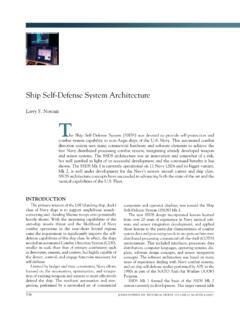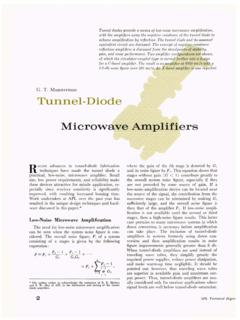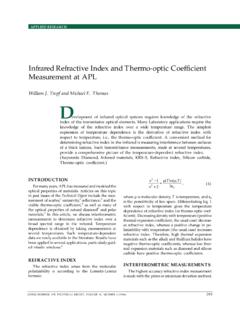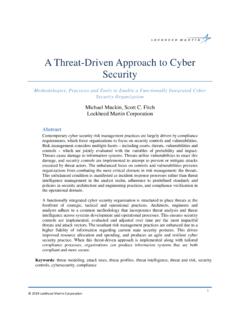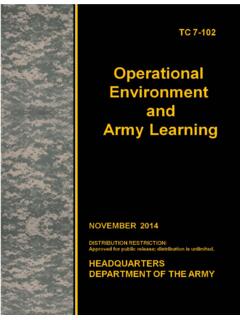Transcription of Overview of Platforms and Combat Systems
1 W. G. BathJohns Hopkins APL Technical Digest, Volume 35, Number 2 (2020), Overview of Platforms and Combat SystemsWilliam G. BathABSTRACTAir and missile defense is a complex process involving the coordinated operation of equipment and computer programs. The most effective defense generally is multiple layers of defense using different technologies in each layer such as long-range hard-kill, followed by hard-kill area defense, followed by both hard-kill and soft-kill (electronic warfare) self-defense. A Combat system must merge, fuse, and de-conflict many sources of sensor data to produce a single usable track picture for decision-making. Throughout, sensors are controlled and sensor resource use is man-aged to meet the overall defense needs.
2 As technical direction agent and technical adviser for many of the Combat system elements, the Johns Hopkins University Applied Physics Laboratory (APL) performs the Systems engineering, analysis, and experimentation that helps the Navy select the most Combat system capability at an affordable overall air and missile defense capability shown in Figure destroyers and cruisers are the Navy s most capable air defense units because of their long-range, multifunction phased-array radars; their inventory of many different anti-air warfare, ballistic missile defense, and electronic warfare weapons; and their complex control processes for processing sensor data, making engagement decisions, and controlling those weapons. Aegis destroyers and cruisers can defend large areas against ballistic missiles by defeating them during the midcourse phase of their flight using the Standard Missile-3 (SM-3) family in the exo-atmosphere, as well as closer to impact during their terminal phase using the SM-6 family in the endo-atmosphere.
3 The Aegis Ashore Combat system deployed in Europe uses a subset of the INTRODUCTIONMost Navy warships have Combat Systems capable of air and missile defense. Those Combat Systems are well described by the detect control engage paradigm; that is, the components of the Combat system can be notionally grouped as follows: Detect components that find and track air and missile targets Control components that identify the targets and make the decisions to engage Engage components that schedule and perform the engagements with the goal of destroying or other-wise negating the targetsThe scope of those components capabilities varies significantly with ship class, resulting in the variation Overview of Platforms and Combat SystemsJohns Hopkins APL Technical Digest, Volume 35, Number 2 (2020), same detect control engage components on land and provides for exo-atmospheric defense of US-deployed forces, their families, and our allies in Europe.
4 Aegis Ballistic Missile Defense (BMD) ships and Aegis Ashore are part of the larger Ballistic Missile Defense system (BMDS), which is, itself, a global Combat system that integrates Navy, Army, and Air Force detect, control, and engage components. Aegis destroyers and cruisers can also defeat attacks from aircraft and cruise missiles. Aegis is capable of extended-range engagements of aircraft and cruise missiles both over sea and over land using the SM-6 surface-to-air missile. With integrated fire control support, SM-6 provides an increased battle space against threats over the horizon. Within the horizon, Aegis can defend both itself (self-defense) and other units (area defense) using the SM-2 missile family and the Evolved Sea Sparrow Missile (ESSM).
5 Aegis also can defeat threats using electronic warfare measures such as jamming and decoys. The Cooperative Engagement Capability (CEC) and tactical Data Link (TDL) networks enable Aegis and other units to fight as a coordinated USS Zumwalt (DDG 1000) brings to the Navy a unique set of volume firepower and precision strike capabilities and is currently nearing deployment. The Zumwalt destroyer has an advanced gun system with a long-range land-attack projectile capable of launch-ing a guided projectile at extended ranges. Its air and missile defense capabilities lie in between those of the Aegis fleet and those of aircraft carriers and amphibious ships. Zumwalt has a vertical launching system similar to that of Aegis and the control capability to launch self-defense missiles as well as SM-2 carriers and amphibious ships are capable of projecting offensive power (Navy air and Marines ashore).
6 The air and missile defense detect control engage components on these ships, however, are gen-erally limited to self-defense. Self-defense is achieved either with electronic warfare, with shorter-range mis-sile Systems such as ESSM and the Rolling Airframe Self-defense(shooter is defended point)Midcourse defenseSea-basedterminal defenseArea defenseNaval integrated re controlBallisticmissileHard killSoft killOnboard and/or offboard electronic attackHeight above EarthCruise missiles and aircraftRange to defended pointAircraft carrierAmphibious landing shipLittoral warfare shipNaval air (not considered here)Aegis destroyerAegis cruiserAegis AshoreZumwalt destroyerFigure 1. Comparison of the air and missile defense capabilities of different Combat Systems .
7 (The chart at the top is not to scale.)W. G. BathJohns Hopkins APL Technical Digest, Volume 35, Number 2 (2020), Missile (RAM), or with guns ( , the Phalanx Close-in Weapon system , or CIWS). The Combat system for these ships is the Ship Self-Defense system (SSDS).Ship Combat Systems are major investments that evolve over time to achieve new capabilities. Aegis and SSDS ships are undergoing major capability upgrades that include significant new sensor capabilities. The Aegis Combat system will evolve from Baseline 9 to Baseline 10 (Figure 2). This evolution features many new capabilities. The AN/SPY-6 Air and Missile Defense Radar (AMDR) will provide multimission capabilities, simultaneously supporting long-range, exo-atmospheric detection, tracking, and discrimination of ballistic mis-siles, as well as area and self-defense against air and sur-face threats .
8 For the BMD capability, increased radar sensitivity and bandwidth over current radar Systems are needed to detect, track, and support engagements of advanced ballistic missile threats at the required ranges, concurrent with area and self-defense against air and surface threats . For the area air defense and self-defense capability, increased sensitivity and clutter capability are needed to detect, react to, and engage stressing threats in the presence of heavy land, sea, and rain clutter. In the control and engage areas, Aegis Baseline 10 includes functional upgrades to make use of the richer data pro-vided by the AMDR, such as Aegis BMD 6 use of the AMDR s increased radar sensitivity and bandwidth in the engagement of ballistic missiles. Aegis Baseline 10 will leverage ongoing developments in active missiles to provide a more effective defense against evolving anti-ship cruise missiles.
9 The AN/SLQ-32(V)7, which deploys in Aegis Baseline 10, includes the Surface Electronic Warfare Improvement Program Block 3, which provides onboard electronic attack. The Soft-Kill Coordinator (SKC) capability, an AN/SLQ-32 command and control subsystem, will be expanded to include coordination of AN/SPY-6 (AMDR) Aegis BMD 6 Active missile upgrades AN/SLQ-32(V)7 Decoy upgrades AN/SPY-6 (AMDR) Aegis BMD 6 Active missile upgrades AN/SLQ-32(V)7 Decoy upgradesSoft killHard killModeling, simulation,and critical experiments to select most capability at affordable costHard killControlNetworksSoft kill* All portions of Baseline 9 are deployed except 9C2, which is imminent. Baseline 9C2 will include AN/SLQ-32(V)6 trade-offs and engineering challengesfor the future New BMD missions Advanced offboard electronic attack Next-generation weapons scheduling algorithms Hard kill/soft kill integration Next-generation sensor netting and integrated re control Force sensor and weapons control Low-cost multifunction X-band radar Railgun/hypervelocity projectile Nonkinetic kill Resilient, cyber-resistant Combat Systems Next-generation Combat information center Next-generation close-in weapon systemRapid, incremental improvements to pacethe threat via AegisSpeed to Capability (on an as-needed basis)
10 Selected newAegis Baseline 10 AMD capabilities2023 Aegis Baseline 9 AMD capabilities today*Aegis Baseline 9 AMD capabilities today*Baselineupgrade AN/SPY-1B/D(mod)/D(V) Aegis BMD VLS (SM-2, SM-6, ESSM) AN/SPQ-9B CIWS Mk 99 (3-4) AN/SLQ-32(V)3/6/SKC* Decoys UPX-29 Command and decision Weapon control CEC TDL AN/SPY-1B/D(mod)/D(V) Aegis BMD VLS (SM-2, SM-6, ESSM) AN/SPQ-9B CIWS Mk 99 (3-4) AN/SLQ-32(V)3/6/SKC* Decoys UPX-29 Command and decision Weapon control CEC TDLF igure 2. Examples of planned Aegis Combat system air and missile defense (AMD) evolution and potential capability trade-offs. VLS, vertical launching of Platforms and Combat SystemsJohns Hopkins APL Technical Digest, Volume 35, Number 2 (2020), onboard electronic attack and an improved inventory of SSDS-based Combat system on aircraft carriers and amphibious ships has historically relied on a suite of older sensors (some initially designed in the 1960s) that have undergone periodic modernizations.

